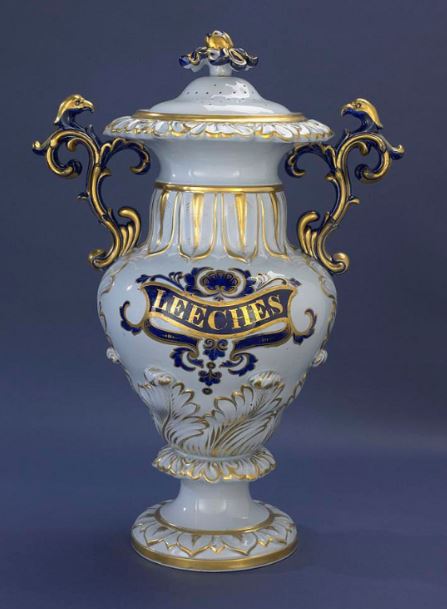The Leech Barometer

The Leech Barometer. Leech jar, 19th c. Nothing too good for the little suckers! Museum of American History, Smithsonian Institution
The Two Nerdy History Girls recently reported on the use of spiders in weather forecasting. Today, as I hope storms are brewing to cool down this beastly heat, I bring you “The Leech Barometer.”
Shaw Hill, near Prairie du Chien, June 2d, 1854.
Mr. Editor—In the early part of my correspondence with the Herald, I took occasion to allude to the barometer as an excellent instrument for foretelling the weather. As these instruments are not readily obtained in this “far west,” and when they are, the price is almost prohibitory to many farmers, I mean here to give you a good substitute. I presume most persons know what a leach is; then put one into a large phial three parts full of clear rain water, regularly change the same thrice a week; and let it stand on a window frame fronting the north. In fair and frosty weather it will be motionless, and rolled up in a spiral form at the bottom of the glass; but prior to rain or snow, it will creep to the top, where, if the rain will be heavy and of some continuance, it will remain a considerable time; if trifling, it will descend. Should the rain or snow be accompanied with wind, it will dart about its habitation with an amazing celerity, and seldom ceases until it begins to blow hard. If a storm of thunder and lightning be approaching, it will be exceedingly agitated, and express its feelings in violent convulsive starts at the top of the glass. It is remarkable, that however fine and serene the weather may be, and not the least indication of a change either from the sky, the barometer, or any other cause whatever, yet if the animal even shifts its position, or move sin a desultory manner, the coincident results will certainly occur within thirty-six hours, frequently within twenty-four hours and sometimes in twelve; though its motions chiefly depend on the fall and duration of the wet, and the strength of the wind.
I kept a leach for several years, and found the foregoing remarks fully borne out.
Grant Co. Herald. Thomas S. Shaw.
Janesville [WI] Gazette 1 July 1854: p. 2
I am not fond of the creatures–a Michigan miniature golf course I frequented as a child had a “leech hazard”–enough to put anyone off their game. But, contrary to my usual practice, I urge you to try this at home and share with the world how it works. (Chriswoodyard8 AT gmail.com) Leeches can easily be obtained simply by standing bare-legged in the shallows of any pond or lake. Or, at greater expense, through your medical supply house.
Chris Woodyard is the author of The Victorian Book of the Dead, The Ghost Wore Black, The Headless Horror, The Face in the Window, and the 7-volume Haunted Ohio series. She is also the chronicler of the adventures of that amiable murderess Mrs Daffodil in A Spot of Bother: Four Macabre Tales. The books are available in paperback and for Kindle. Indexes and fact sheets for all of these books may be found by searching hauntedohiobooks.com. Join her on FB at Haunted Ohio by Chris Woodyard or The Victorian Book of the Dead. And visit her newest blog, The Victorian Book of the Dead.
